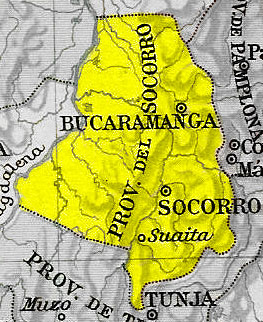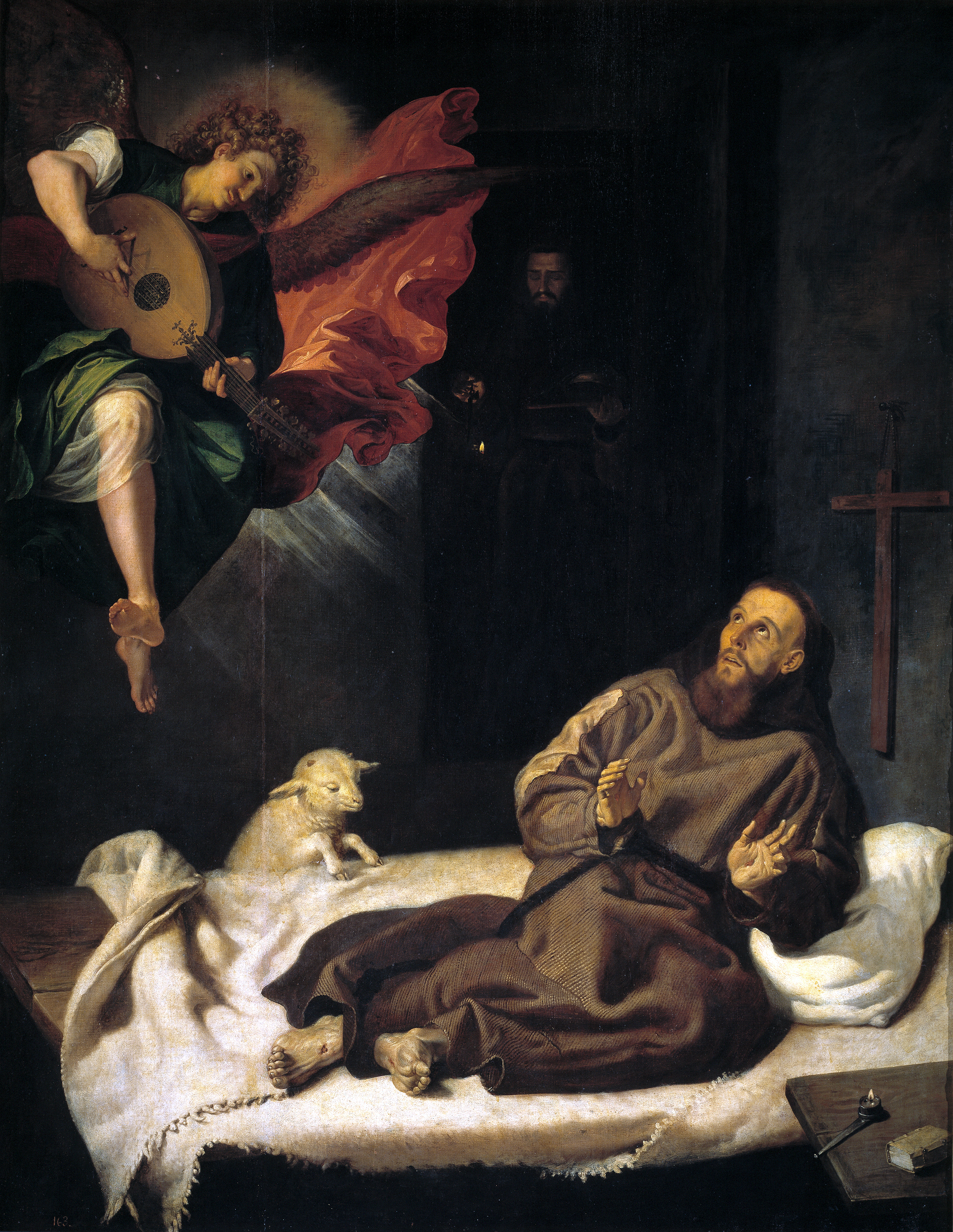|
Miguel Acuña
Fray Miguel Acuña (1788-1847) was a Franciscan priest and medical practitioner in New Granada (present-day Colombia). He was born in Zapatoca in the province of Socorro, and was received into the Franciscan order at the age of 21. He was famous in Bogota for his knowledge of medicine and for his exemplary life. He spent the majority of his religious life in the convent of San Francisco de Bogotá, where he was visited by a regular stream of people from all walks of life, eager to seek relief from their ailments through his prescriptions. He died in Bogota in 1847. See also *Catholic Church in Colombia The Colombian Catholic Church, or Catholic Church in Colombia, is the branch of the Roman Catholic Church in the South American nation of Colombia. Organization It is organized into 13 ecclesiastical provinces, subdivided into 13 archdiocese ... References 1788 births 1847 deaths 19th-century Colombian Roman Catholic priests {{Colombia-bio-stub ... [...More Info...] [...Related Items...] OR: [Wikipedia] [Google] [Baidu] |
Franciscan
The Franciscans are a group of related Mendicant orders, mendicant Christianity, Christian Catholic religious order, religious orders within the Catholic Church. Founded in 1209 by Italian Catholic friar Francis of Assisi, these orders include three independent orders for men (the Order of Friars Minor being the largest contemporary male order), orders for women religious such as the Order of Saint Clare, and the Third Order of Saint Francis open to male and female members. They adhere to the teachings and spiritual disciplines of the founder and of his main associates and followers, such as Clare of Assisi, Anthony of Padua, and Elizabeth of Hungary. Several smaller Franciscan spirituality in Protestantism, Protestant Franciscan orders exist as well, notably in the Anglican and Lutheran traditions (e.g. the Community of Francis and Clare). Francis began preaching around 1207 and traveled to Rome to seek approval from Pope Innocent III in 1209 to form a new religious order. The o ... [...More Info...] [...Related Items...] OR: [Wikipedia] [Google] [Baidu] |
Priest
A priest is a religious leader authorized to perform the sacred rituals of a religion, especially as a mediatory agent between humans and one or more deities. They also have the authority or power to administer religious rites; in particular, rites of sacrifice to, and propitiation of, a deity or deities. Their office or position is the 'priesthood', a term which also may apply to such persons collectively. A priest may have the duty to hear confessions periodically, give marriage counseling, provide prenuptial counseling, give spiritual direction, teach catechism, or visit those confined indoors, such as the sick in hospitals and nursing homes. Description According to the trifunctional hypothesis of prehistoric Proto-Indo-European society, priests have existed since the earliest of times and in the simplest societies, most likely as a result of agricultural surplus and consequent social stratification. The necessity to read sacred texts and keep temple or church rec ... [...More Info...] [...Related Items...] OR: [Wikipedia] [Google] [Baidu] |
Viceroyalty Of New Granada
The Viceroyalty of New Granada ( es, Virreinato de Nueva Granada, links=no ) also called Viceroyalty of the New Kingdom of Granada or Viceroyalty of Santafé was the name given on 27 May 1717, to the jurisdiction of the Spanish Empire in northern South America, corresponding to modern Colombia, Ecuador, Panama and Venezuela. Created in 1717 by King Felipe V, as part of a new territorial control policy, it was suspended in 1723 for financial problems and was restored in 1739 until the independence movement suspended it again in 1810. The territory corresponding to Panama was incorporated later in 1739, and the provinces of Venezuela were separated from the Viceroyalty and assigned to the Captaincy General of Venezuela in 1777. In addition to those core areas, the territory of the Viceroyalty of New Granada included Guyana, Trinidad and Tobago, southwestern Suriname, parts of northwestern Brazil, and northern Peru. Colonial history Two centuries after the establishment of the Ne ... [...More Info...] [...Related Items...] OR: [Wikipedia] [Google] [Baidu] |
Colombia
Colombia (, ; ), officially the Republic of Colombia, is a country in South America with insular regions in North America—near Nicaragua's Caribbean coast—as well as in the Pacific Ocean. The Colombian mainland is bordered by the Caribbean Sea to the north, Venezuela to the east and northeast, Brazil to the southeast, Ecuador and Peru to the south and southwest, the Pacific Ocean to the west, and Panama to the northwest. Colombia is divided into 32 departments and the Capital District of Bogotá, the country's largest city. It covers an area of 1,141,748 square kilometers (440,831 sq mi), and has a population of 52 million. Colombia's cultural heritage—including language, religion, cuisine, and art—reflects its history as a Spanish colony, fusing cultural elements brought by immigration from Europe and the Middle East, with those brought by enslaved Africans, as well as with those of the various Amerindian civilizations that predate colonization. Spanish is th ... [...More Info...] [...Related Items...] OR: [Wikipedia] [Google] [Baidu] |
Zapatoca
Zapatoca () is a town and municipality in the Santander Department in northeastern Colombia. It is at a high altitude and is a common stop between Bucaramanga and San Gil. It was built in the early 17th century by the Spain, Spanish conquistadores. Notable people * Miguel Acuña (1788-1847), Franciscan priest and medical practitioner * José de Jesús Pimiento Rodríguez (1919 - 2019 in Floridablanca, Santander, Floridablanca) was a Prelate of the Catholic Church. Until his death the age of 100 he was the oldest living cardinal. * Carlos Toledo Plata (1932 - 1984 in Bucaramanga) was a doctor, politician and co-founder and early leader of the guerrilla movement known as 19th of April Movement, M-19. References Municipalities of Santander Department {{Santander-geo-stub ... [...More Info...] [...Related Items...] OR: [Wikipedia] [Google] [Baidu] |
Socorro Province
Socorro Province was one of the provinces of Gran Colombia. It belonged to the Boyacá Department which was created in 1824. See also *Revolt of the Comuneros (New Granada) The Revolt of the Comuneros was a popular uprising in the Viceroyalty of New Granada (now Colombia and parts of Venezuela) against the Spanish authorities from March through October 1781. The revolt was in reaction to the increase in taxation to ... Provinces of Gran Colombia Provinces of the Republic of New Granada {{Boyacá-geo-stub ... [...More Info...] [...Related Items...] OR: [Wikipedia] [Google] [Baidu] |
Franciscans
, image = FrancescoCoA PioM.svg , image_size = 200px , caption = A cross, Christ's arm and Saint Francis's arm, a universal symbol of the Franciscans , abbreviation = OFM , predecessor = , merged = , formation = , founder = Francis of Assisi , founding_location = , extinction = , merger = , type = Mendicant Order of Pontifical Right for men , status = , purpose = , headquarters = Via S. Maria Mediatrice 25, 00165 Rome, Italy , location = , coords = , region = , services = , membership = 12,476 members (8,512 priests) as of 2020 , language = , sec_gen = , leader_title = Motto , leader_name = ''Pax et bonum'' ''Peace and llgood'' , leader_title2 = Minister General , leader_name2 = ... [...More Info...] [...Related Items...] OR: [Wikipedia] [Google] [Baidu] |
Medicine
Medicine is the science and practice of caring for a patient, managing the diagnosis, prognosis, prevention, treatment, palliation of their injury or disease, and promoting their health. Medicine encompasses a variety of health care practices evolved to maintain and restore health by the prevention and treatment of illness. Contemporary medicine applies biomedical sciences, biomedical research, genetics, and medical technology to diagnose, treat, and prevent injury and disease, typically through pharmaceuticals or surgery, but also through therapies as diverse as psychotherapy, external splints and traction, medical devices, biologics, and ionizing radiation, amongst others. Medicine has been practiced since prehistoric times, and for most of this time it was an art (an area of skill and knowledge), frequently having connections to the religious and philosophical beliefs of local culture. For example, a medicine man would apply herbs and say prayers for healing, o ... [...More Info...] [...Related Items...] OR: [Wikipedia] [Google] [Baidu] |
San Francisco
San Francisco (; Spanish language, Spanish for "Francis of Assisi, Saint Francis"), officially the City and County of San Francisco, is the commercial, financial, and cultural center of Northern California. The city proper is the List of California cities by population, fourth most populous in California and List of United States cities by population, 17th most populous in the United States, with 815,201 residents as of 2021. It covers a land area of , at the end of the San Francisco Peninsula, making it the second most densely populated large U.S. city after New York City, and the County statistics of the United States, fifth most densely populated U.S. county, behind only four of the five New York City boroughs. Among the 91 U.S. cities proper with over 250,000 residents, San Francisco was ranked first by per capita income (at $160,749) and sixth by aggregate income as of 2021. Colloquial nicknames for San Francisco include ''SF'', ''San Fran'', ''The '', ''Frisco'', and '' ... [...More Info...] [...Related Items...] OR: [Wikipedia] [Google] [Baidu] |
Bogotá
Bogotá (, also , , ), officially Bogotá, Distrito Capital, abbreviated Bogotá, D.C., and formerly known as Santa Fe de Bogotá (; ) during the Spanish period and between 1991 and 2000, is the capital city of Colombia, and one of the largest cities in the world. The city is administered as the Capital District, as well as the capital of, though not part of, the surrounding department of Cundinamarca. Bogotá is a territorial entity of the first order, with the same administrative status as the departments of Colombia. It is the political, economic, administrative, and industrial center of the country. Bogotá was founded as the capital of the New Kingdom of Granada on 6 August 1538 by Spanish conquistador Gonzalo Jiménez de Quesada after a harsh expedition into the Andes conquering the Muisca, the indigenous inhabitants of the Altiplano. Santafé (its name after 1540) became the seat of the government of the Spanish Royal Audiencia of the New Kingdom of Granada (cre ... [...More Info...] [...Related Items...] OR: [Wikipedia] [Google] [Baidu] |
Catholic Church In Colombia
The Colombian Catholic Church, or Catholic Church in Colombia, is the branch of the Roman Catholic Church in the South American nation of Colombia. Organization It is organized into 13 ecclesiastical provinces, subdivided into 13 archdioceses and 52 dioceses, and a Maronite apostolic exarchate. Over 120 religious orders, institutes, and lay organizations run hundreds of primary and secondary schools, hospitals, clinics, orphanages, colleges, and 8 universities across the country. The best known is Pontificia Universidad Javeriana (in Cali) and Pontificia Universidad Javeriana (in Bogotá), both Jesuit universities.Annuario Pontificio, 2009. Based on studies and a survey, about 90% of the Colombian population adheres to Christianity, the majority of which (70.9%) are Catholic, while 16.7% adhere to Protestantism (primarily Evangelicalism). History Catholicism was introduced to the country 1508. Two dioceses were organized in 1534. The Church grow significantly by the mid ... [...More Info...] [...Related Items...] OR: [Wikipedia] [Google] [Baidu] |






